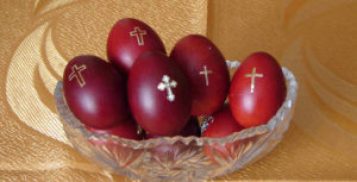CELEBRATE EASTER AS GREEK DO
In the spring, the most important religious ceremony is Easter.
Throughout Holy Week, different processions prepare the Resurrection of Christ.
Easter week, really begins on Monday of Holy Week. This is a real week of fasting.
On Good Friday, the procession of the Epitaph which symbolizes the funeral of Christ, followed by the faithful holding candles lit brown, goes around the church.


Holy Saturday, at midnight, the priest announces the resurrection of Christ in the forecourt of the church. At the moment when the « CHRISTOS ANESTI » is pronounced by the priest, the faithful light their candle to the flame offered by it. The bells are ringing, the people full of joy, embrace and congratulate themselves by calling themselves « CHRISTOS ANESTI » (CHRIST IS RISEN). Then they go home, the candle lighted in his hand.
On returning home, the head of the family traces the sign of the cross at the top of the embrasure of his door, with the smoke of the candle, in protection of all evils. Then he lights a small photophore (kandili) and these candles are kept near the icons.

Then we sit down to eat the red eggs (tsougrisma) and eat the traditional soup made of lamb and lemon offal (maghiritsa).



Easter Sunday turns into a real « debauchery » of food, with paschal lamb etc., in order to celebrate the resurrection and the end of fasting
The custom is lamb on the spit that is cooked outdoors. Everywhere in Greece, on Easter Sunday, families and friends are set up in the courtyards of the houses to roast the lamb.
The spit is rotated slowly by a person who coats the lamb from time to time with a mixture of oil, oregano and lemon using a brush.


Sheep and Kokoretsi
Kokoretsi is also cooked, consisting essentially of casings and offal of lamb sliced with spices and aromatic herbs.

Kokoretsi
We also serve all the salty or sweet specialties of the hostess: salads, pita, feta and desserts tsoureki, koulourakia …

Tsoureki

Koulourakia

Kaltsounakia

Meletinia


